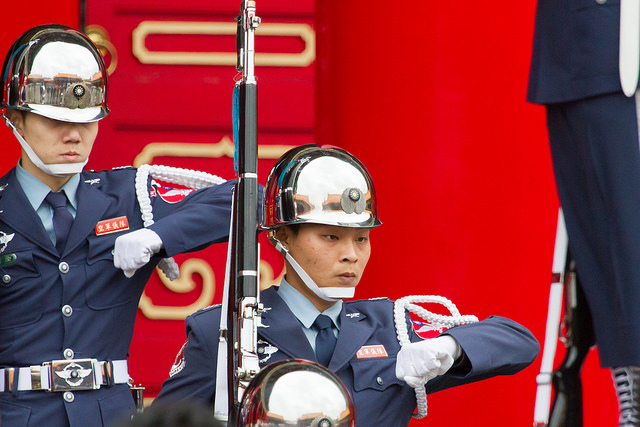The People’s Republic of China (PRC) announced on March 4 that it would raise its defense budget by 10.1 percent in 2015, which continues an almost unbroken pattern of double-digit annual increases over the past two decades. Meanwhile, defense spending by the Republic of China (ROC) on Taiwan, which faces an ever-growing military threat from the PRC, has languished. In 2015, Taiwan’s Ministry of National Defense’s (MND) budget saw its first bump in funds since 2012 – a 2.6 percent increase from $10.5 to $10.7 billion USD. For the first time in seven years, defense spending as a percentage of total government spending will rise, but only .2 percent. Since 2008, the MND budget has decreased as a percentage of Taiwan’s GDP – currently hovering just above 2 percent, well below President Ma Ying-jeou’s pledge to sustain an investment in defense of not less than 3 percent.
The disparity between the size of the PRC economy ($10.35 trillion) and Taiwan’s economy ($517.02 billion) makes it impossible for Taiwan to keep pace with Chinese defense spending. However, Taiwan’s preference in recent years for butter over guns is jeopardizing its security in two ways. First, Taiwan’s diminishing ability to maintain a credible deterrent against an attack from Mainland China could provide incentives for Beijing to pressure Taiwan to engage in political talks or use military force to achieve its objective of reunification. With the real possibility of a return to power in 2016 of the Democratic Progressive Party (DPP), which has traditionally supported Taiwan independence, Taiwan’s growing vulnerability could tempt Chinese President Xi Jinping to adopt a more coercive or even violent approach. Second, Taipei’s low defense spending raises questions about Taiwan’s commitment to its own defense, which could have implications for U.S. willingness to help defend the island in the event of a PRC attack.
Why, then, is Taiwan not allocating greater resources to defense? A major factor is the improvement in cross-Strait relations, which has importantly lowered the risk of conflict, but has also reduced public perception of the threat from Mainland China. Since coming to power in 2008, Taiwan’s President Ma Ying-jeou has overseen a new phase of stabilization in China-Taiwan relations in which economic and social exchanges have expanded dramatically. As a result, Taiwan’s citizens’ fears of a military attack have receded. Other concerns have emerged instead, including rising unemployment, the widening income gap between rich and poor, growing government debt, the challenges posed by an aging population, and a variety of social issues.
The trend of declining defense spending as a share of government spending (from 2008 to 2013) and GDP (from 2008 to 2014) has not gone unnoticed by Washington. The U.S. Department of Defense’s report to Congress Military and Security Developments Involving the People’s Republic of China 2013, lamented Taiwan’s choice to spend more on personnel salaries while “diverting funds from foreign and indigenous [weapons] acquisition programs.” At the same time, however, the U.S. has commended the efforts of Taiwan’s military to make the most of its limited funds by focusing on an asymmetrical homeland defense strategy. For example, DoD’s 2014 report highlighted Taiwan’s procurement of fast-attack boats, armed helicopters, radar systems, and other key anti-amphibious assault capabilities. Taiwan has also sought to strengthen indigenous defense production. This is essential as no country other than the U.S. is willing to supply Taiwan with weapons in the face of growing Chinese power. There is also recognition that MND is focused on realizing President Ma’s commitment to shift Taiwan from a conscription-based force to a smaller, more professionalized all-volunteer military – an expensive transition.
But are these measures sufficient to deter an attack from the Mainland and bolster U.S. confidence that Taiwan will defend itself, if necessary? Then-Minister of National Defense Yen Ming projected in 2013 that Taiwan’s military forces could hold off a PRC invasion by themselves for the grim estimate of only one month. Even that prediction is likely overly optimistic. The 2013 National Defense Report, which is the latest one issued, assessed that China will have the capability to forcibly reunite Taiwan and the Mainland by 2020. It judged that the PRC’s intelligence, ground forces, navy and air force are making significant progress towards acquiring capabilities to blockade Taiwan’s sea routes and control the air space, as well as to deter third parties from intervening during a Chinese assault.
More resources are evidently needed. The DPP promises to raise the defense budget to 3 percent of GDP if it returns to power, but many observers are skeptical that it would follow through on this pledge. After all, when the DPP was the ruling party, defense spending dropped annually as a percentage of GDP from 2.9 in 2001 to 2.1 in 2006, and then inched upwards to 2.4 percent in 2007, its final year in office. This suggests that regardless of which party is elected in 2016, significant increases in defense spending are unlikely. Competing pressures from the electorate to support social welfare programs means that a marginal reversal of the current downward trend is the best case scenario.
Taiwan cannot outspend China and it cannot prevent the cross-Strait capabilities gap from widening. But Taiwan can raise the costs and risks to the PRC of an attack, which would likely reduce the possibility that Beijing will opt to use military force to achieve its goals. To do so, Taiwan must devote greater resources to defense spending. This will require explaining to the people of Taiwan that the Chinese military threat is growing even though cross-Strait relations have improved, and that therefore the island must have an effective defense. If Taiwan fails to spend adequately on its security, besides weakening deterrence, it will also increase doubts in the U.S. about Taiwan’s commitment to defend itself—doubts that could lead to the erosion of American support to defend Taiwan in a crisis.
